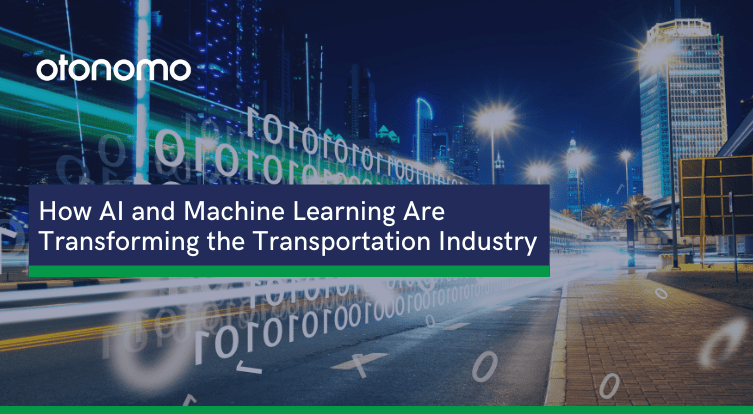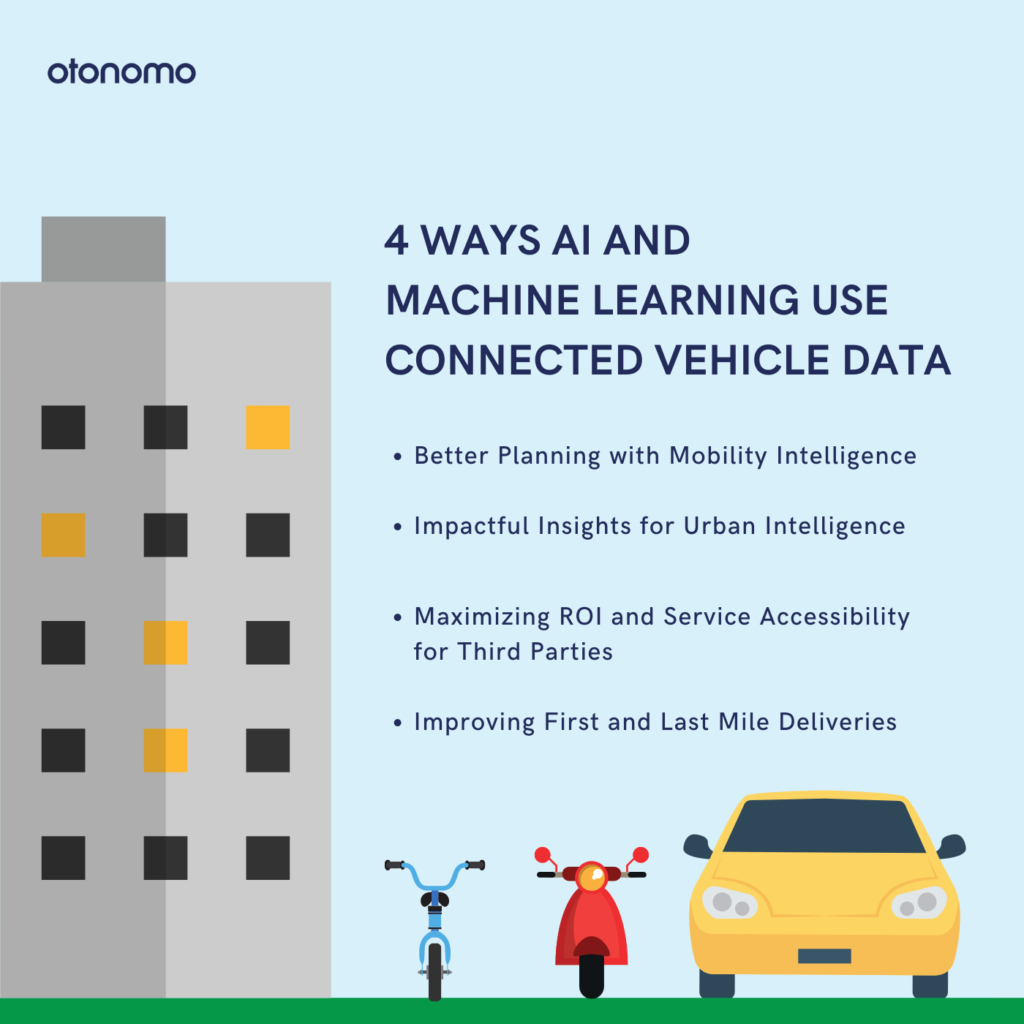
By harnessing connected vehicle data, decision-makers can improve their transportation and mobility-related AI solutions and machine learning models to grow their businesses and improve city living with greater accuracy and insight. Connected vehicles, soon to be known as “vehicles”, as 75% of all cars will be connected within the next few years, generate massive amounts of data. Their data is the fuel on which artificial intelligence (AI) and machine learning (ML) based transportation and mobility solutions thrive.
The ever-growing use of AI in transportation is here to stay, and here are 4 areas where connected vehicle data is having an impact.
Better Planning with Mobility Intelligence – Understanding Transportation Networks Enables Improved Decision Making for MaaS, and EV Charging Station Providers
AI in transportation already works around the clock to support cities and municipalities in traffic management, smart routing, and in reducing congestion and emissions. As the number of connected vehicles on the road continues to grow, and as the data received gets richer and richer with multi-layered data, a sustainable transport system will become achievable.
These sustainable systems will leverage real-time data to deliver additional benefits. And utilize data that includes more than just location and heading. Multi-layered data includes information on hazards, construction, weather, road conditions, and more. And the connected vehicle data will support AI-based decision making by empowering more accurate predictive models for traffic volume, congestion, and safety incidents.
The connected vehicle data can be used for routing, which can be optimized for reduced logistics, aimed specifically at time-sensitive cold chain or pharma use cases, ride-sharing incentives, or for use cases like drivers who are coming to end of shift. Machine learning and AI can also be used to help stakeholders optimize public transport links, resource allotment, and create accurate, measurable hyperlocal network designs, or map a specific area in the context of its multi-modal demand and unique requirements.
Getting a better understanding of traffic is critical for supporting multi-modal transportation and for making decisions about how and where to deploy micro-mobility services. This use of AI becomes even more critical when it come to the deployment of charging stations for electric vehicles. EV charging stations require a large financial investment, involve many infrastructure-related factors (including grid readiness and zoning), which are nearly impossible to change after the fact. This makes AI-supported decisions on placement and the types of points deployed paramount for the success deployment of EV charging stations.

Impactful Insights for Urban Intelligence – Data Driven Visibility into Routes and Road Segments
Intelligent traffic management systems (ITS) are pioneers in leveraging AI for transportation purposes. We are seeing success stories like the city of Hangzhou in China. Previously, Hangzhou was the fifth most congested city in China. It has now dropped out of the top 50 as a result of implementing intelligent traffic systems throughout the city.
ITS and systems like it, collect traffic data in real-time and then coordinate traffic signals in response to the data from around the city to prevent or reduce congestion. They can also collect information on traffic violations, such as vehicles running red lights, and submit this information to the authorities for immediate action, creating more accountability for drivers.
With connected vehicle data to improve this kind of artificial intelligence, ITS can continue to develop and expand its impact without needing additional hardware like road sensors and cameras. Embedded vehicle telematics requires no maintenance and can cover a wide area without installing devices, as the driver-consented data is gathered from connected vehicles already on the road. In addition to the reduced costs and logistics, rich connected vehicle data can be utilized for a multitude of use cases providing opportunities for further optimization.
The benefits of machine learning and AI however do not require the deployment of a full ITS system. Leveraging data to understand Origin-Destination patterns (OD matrix) and even more impressively Origin-via-Destination (OvD) matrix that take into account waypoints, is key in understanding how the city works and in creating viable plans for it. All this became possible thanks to the development of machine learning and artificial intelligence.
Maximizing ROI and Service Accessibility for Third Parties
Bringing together data and information from multiple players is what super-charges AI solutions. The data fed into the AI solution is transformed into information and insights, and in turn they can power a whole host of services and solutions that benefit the entire eco-system. These insights can impact everything and anything in the city. From planning to zoning. For example, AI-driven intelligence can help plan a smart track that can be used to optimize and co-ordinate autonomous vehicles or ride-sharing applications, infotainment options to passengers on public transport, route optimization for first responders, and more.
Connected vehicle data gives a more accurate measure of traffic flow, doing away with a lot of the noise that comes from traditional data sources like GPS or road sensors. This means that smart AI-based applications leveraging connected vehicle data can benefit drivers, riders, pedestrians, basically anyone or any organization in the mobility ecosystem of the city.
Improving First and Last Mile Deliveries
Last mile delivery is more than half of a business’s overall shipping costs, and with the rush to online shopping since the COVID-19 pandemic – the race is well and truly on to reduce this overhead. AI and ML is being used in last-mile delivery to improve accuracy and precision of drop-off points for parcels, for better route planning and route optimization in real-time, and to track and trace deliveries when things don’t go to plan.
Using machine learning models to provide better insights into the most intelligent routes for the first and last mile, even when faced with real-time challenges like an unexpected accident on the road ahead. AI tools can also be used to provide transportation alternatives when congestion or failed deliveries trigger new routes and pick-up points. And they can also be used to reduce friction and speed up journey times. Hyperlocal deliveries and fulfillment centers are becoming increasingly common in an effort to solve the cost of the last mile, but businesses need to know which partnerships will be strategic and provide true ROI. By leveraging connected vehicle data, you can eliminate the gaps in your trips data, and isolate information about your specific trade areas in far more granular detail.
Ready to dive-deep into the world of mobility intelligence? Otonomo’s connected vehicle data platform will reshape the way you think about your AI or Machine Learning project – let’s talk.












More Stories
Click Shield from MIKROE simplifies integration of Arduino Portenta with over 1600 Click boards
Optimizing Mid-Power Silicon MOSFETs for Automotive Applications
Paolo Pininfarina named the 2024 Laureate of The American Prize for Design